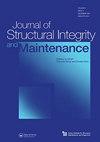Densified wood dowel reinforcement of timber perpendicular to the grain: a pilot study
IF 3.1
Q2 ENGINEERING, CIVIL
Journal of Structural Integrity and Maintenance
Pub Date : 2021-06-07
DOI:10.1080/24705314.2021.1906090
引用次数: 7
Abstract
ABSTRACT An investigation was carried out to examine the potential to utilise densified wood dowels as a reinforcement for timber subjected to compression loading perpendicular to the grain. While timber has a high strength-to-weight ratio parallel to the grain, it demonstrates poor strength perpendicular to the grain and in recent years there has been a significant number of studies examining the use of steel screws and bonded-in rods as reinforcement in this area. This is becoming more and more important with the increased use of timber in medium-to-high rise structures. In this study, thermo-mechanical densified wood in the form of dowels are utilised as compression reinforcement perpendicular to the grain and tested to failure. Thermo-mechanically densified dowel reinforcement arrangements of 2, 4, and 6 dowels are examined experimentally under a compressive load and compared to timber samples similarly reinforced but with steel self-tapping screws. The results have demonstrated the potential to utilised densified wood to create an all-wood solution to reinforce against compressive stresses perpendicular to the grain. Additionally, modifications to recently proposed Eurocode 5 recommendations for the design of compression reinforcement using self-tapping steel screws are presented, which are suitable for the design of compression reinforcement using densified wood dowels.垂直于木纹的致密木榫加固:初步研究
进行了一项调查,以检查利用致密木销钉作为木材承受垂直于颗粒的压缩载荷的加固的潜力。虽然木材在平行于纹路的方向上具有很高的强度重量比,但在垂直于纹路的方向上却表现出较差的强度。近年来,有大量研究检查了在这一领域使用钢螺钉和粘结杆作为加固材料。随着木材在中高层建筑中的使用越来越多,这一点变得越来越重要。在这项研究中,以销子形式的热机械致密木材被用作垂直于颗粒的压缩增强材料,并进行了失效测试。在压缩载荷下,对2、4和6个热机械致密销钉加固布置进行了实验研究,并与使用钢自攻螺钉进行类似加固的木材样品进行了比较。结果表明,利用致密木材创造全木材解决方案的潜力,以增强垂直于颗粒的压应力。此外,对最近提出的使用自攻钢螺钉的抗压加固设计的欧洲规范5建议进行了修改,这些建议适用于使用致密木钉的抗压加固设计。
本文章由计算机程序翻译,如有差异,请以英文原文为准。
求助全文
约1分钟内获得全文
求助全文
来源期刊

Journal of Structural Integrity and Maintenance
ENGINEERING, CIVIL-
CiteScore
3.90
自引率
9.50%
发文量
24
 求助内容:
求助内容: 应助结果提醒方式:
应助结果提醒方式:


